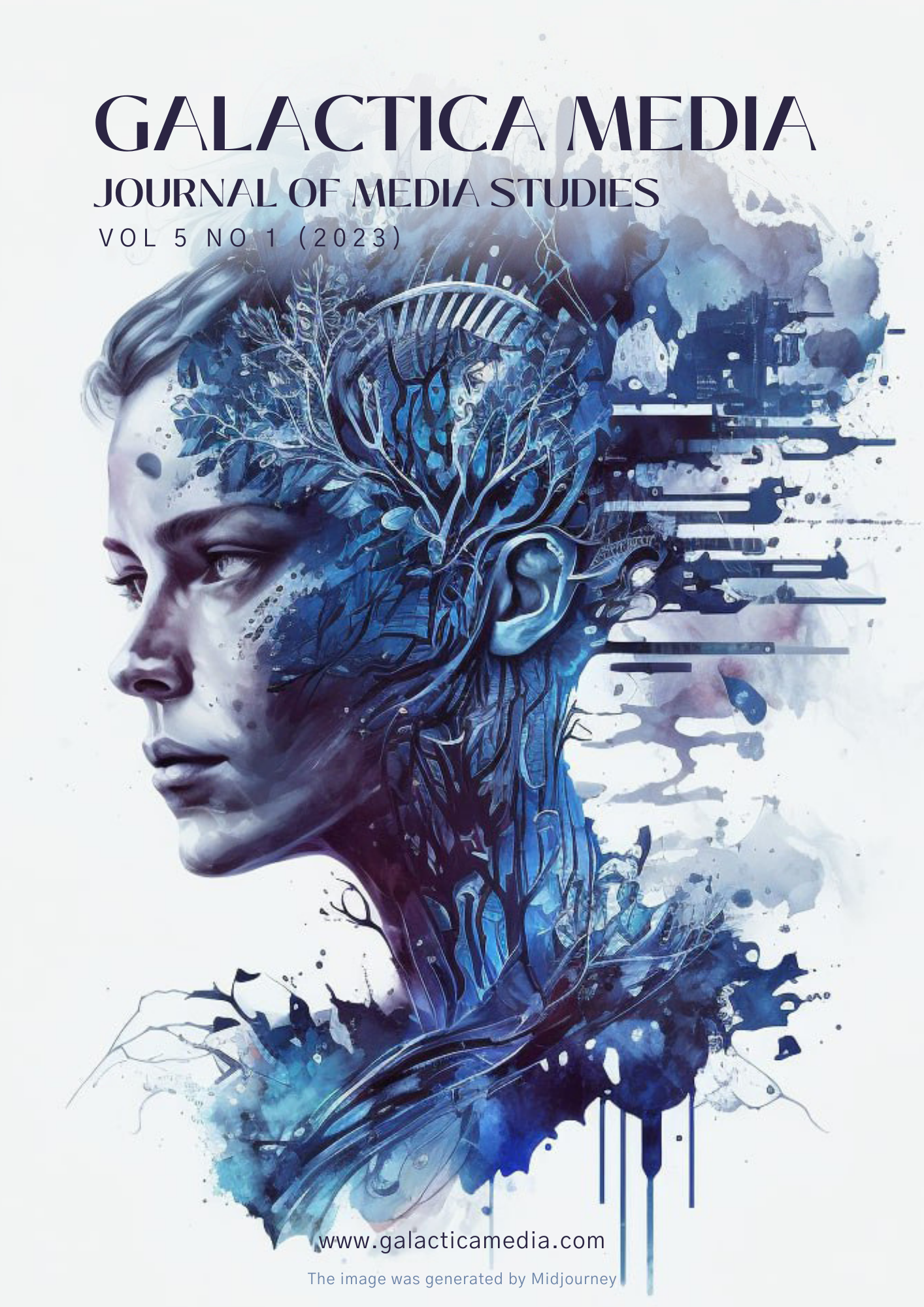Abstract
The article forms a matrix of the main propositions and markers of artificial intelligence in non-professional (philistine) discourses. The study is implemented on the Internet using special tools. The subject of the analysis is the search queries in the main ‘Google’ and ‘Yandex’ services, thematic communities, social networks and users’ comments. The definition of the matrix of non-professional stereotypical labeling of artificial intelligence as an actual developing technology allows us to see a picture of a new metaphysics. “Technological” metaphysics is inextricably linked with mythological thinking and significantly affects the absorption of scientific and technological developments. It also influences the constructive critical attitude towards the physical condition. The article substantiates that this modern technical mythology, which includes many speculative assumptions, has a double meaning: on the one hand, it “domesticates” technology, and on the other hand, it creates an insurmountable barrier for the convergence of spiritual and religious scope and the scientific worldview. The definition and subsequent refinement of the mythological matrix is necessary for the effective implementation of innovative programs, adjustment of those to the education system, constructive dialogue between the state, scientists, and users.
References
Bibarsov, D. A. (2020). “The Man of Play” and “the Man of Technology:” Sociocultural Characteristics and the Problem of Conjugation. In Social Processes in Contemporary Russian Society: Problems and Prospects (pp. 332–338). Irkutsk State University Press. (In Russian).
Chae, D. H., Clouston, S., Hatzenbuehler, M. L., Kramer, M. R., Cooper, H. L. F., Wilson, S. M., Stephens-Davidowitz, S. I., Gold, R. S., & Link, B. G. (2015). Association between an Internet-Based Measure of Area Racism and Black Mortality. PLOS ONE, 10(4), e0122963. https://doi.org/10.1371/journal.pone.0122963
Chae, D. H., Clouston, S., Martz, C. D., Hatzenbuehler, M. L., Cooper, H. L. F., Turpin, R., Stephens-Davidowitz, S., & Kramer, M. R. (2018). Area racism and birth outcomes among Blacks in the United States. Social Science & Medicine, 199, 49–55. https://doi.org/10.1016/j.socscimed.2017.04.019
Davis, E. (2008). Technognosis: Myth, magic and mysticism in the information age. AST. (In Russian).
Delio, I. (2020). Religion and Posthuman Life: A Note on Teilhard de Chardin’s Vision. Toronto Journal of Theology, 36(2), 223–234. https://doi.org/10.3138/tjt-2020-0051
Deng, Y., Han, S.-Y., Fan, W., & Sun, T. (2020). Research on the Application of Artificial Intelligence Technology in Public Product Design of Intelligent Scenic Spot. 2020 International Conference on Intelligent Transportation, Big Data & Smart City (ICITBS), 930–933. https://doi.org/10.1109/ICITBS49701.2020.00206
Deo, R. C. (2015). Machine Learning in Medicine. Circulation, 132(20), 1920–1930. https://doi.org/10.1161/CIRCULATIONAHA.115.001593
Dukhanina, L. N., & Maximenko, A. A. (2020). Problems of the implementation of artificial intelligence in education. Perspectives of Science and Education, 46(4), 23–35. https://doi.org/10.32744/pse.2020.4.2
Fukuyama, F. (2008). Our post-human future. AST. (In Russian).
Galván, J. M. (2020). Moral virtue of religion and technology of artificial intelligence. Quaderni di diritto e politica ecclesiastica, 23(2), 367–378. https://doi.org/10.1440/98368
Gasparov, I. (2021). Would Existence of Hell Be an Evil? State, Religion, Church in Russia and beyond, 39(4), 51–71. https://doi.org/10.22394/2073-7203-2021-39-4-51-71 (In Russian).
Halpern, D., & Katz, J. E. (2012). Unveiling robotophobia and cyber-dystopianism: The role of gender, technology and religion on attitudes towards robots. Proceedings of the Seventh Annual ACM/IEEE International Conference on Human-Robot Interaction – HRI ’12, 139. https://doi.org/10.1145/2157689.2157724
Haynes, R. (2003). From Alchemy to Artificial Intelligence: Stereotypes of the Scientist in Western Literature. Public Understanding of Science, 12(3), 243–253. https://doi.org/10.1177/0963662503123003
Kashkarov, A. M. (2019). The techno-ideology of modern society as a socio-cultural factor in the formation of the technogenic man. Caspian Region: Politics, Economics, Culture, 3, 135‑141. (In Russian).
Khrapov, S. A. (2019). “Man of technology” in the socio-cultural space of the technogenic civilisation. Astrakhan State University Press. (In Russian).
Kimura, T. (2017). Robotics and AI in the sociology of religion: A human in imago roboticae. Social Compass, 64(1), 6–22. https://doi.org/10.1177/0037768616683326
Kononenko, I. (2001). Machine learning for medical diagnosis: History, state of the art and perspective. Artificial Intelligence in Medicine, 23(1), 89–109. https://doi.org/10.1016/S0933-3657(01)00077-X
Reed, R. (2021). The theology of GPT‐2: Religion and artificial intelligence. Religion Compass, 15(11). https://doi.org/10.1111/rec3.12422
Rossano, M. J. (2001). Artificial Intelligence, Religion, and Community Concern. Zygon®, 36(1), 57–75. https://doi.org/10.1111/0591-2385.00340
Searle, D. (1998). Consciousness, the brain and programmes. In Analytical Philosophy: Formation and Development (anthology) (pp. 376–400). Dom intellektual'noj knigi. (In Russian).
Shestak, V., & Volevodz, A. (2019). Modern Requirements of the Legal Support of Artificial Intelligence: A View from Russia. Russian Journal of Criminology, 13(2), 197–206. https://doi.org/10.17150/2500-4255.2019.13(2).197-206
Singler, B. (2018). An Introduction to Artificial Intelligence and Religion For the Religious Studies Scholar. Implicit Religion, 20(3), 215–231. https://doi.org/10.1558/imre.35901
Stephens-Davidowitz, S. (2014). The cost of racial animus on a black candidate: Evidence using Google search data. Journal of Public Economics, 118, 26–40. https://doi.org/10.1016/j.jpubeco.2014.04.010
Stephens-Davidowitz, S., Varian, H., & Smith, M. D. (2017). Super returns to Super Bowl ads? Quantitative Marketing and Economics, 15(1), 1–28. https://doi.org/10.1007/s11129-016-9179-0
Stephenson, N., Shane, E., Chase, J., Rowland, J., Ries, D., Justice, N., Zhang, J., Chan, L., & Cao, R. (2019). Survey of Machine Learning Techniques in Drug Discovery. Current Drug Metabolism, 20(3), 185–193. https://doi.org/10.2174/1389200219666180820112457

This work is licensed under a Creative Commons Attribution 4.0 International License.

